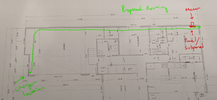I requested a quote from multiple Tesla certified electricians over the past week. My panel is located on the back right corner of my ranch house inside a finished basement with the garage in the front right corner.
The simplest routing is to exit at the rear, go up to the attic, run across the entire house and drop it down into the garage. I'm looking at roughly 150'.
All three electricians that have come out have provided quotes that say 60 amp breaker and either 6/2 or 6/3 Romex. I asked the two installers I thought about using, "Is the conductor correctly sized? I thought Romex is only rated to carry a max of 55 amps. And since this is a 48 amp continuous load it has to be able to carry 125% of the expected load for a total of 60 amps."
One told me "I'm thinking backwards, that since there is no 55 amp breaker you can round up", which doesn't actually make any sense in this situation to me.
The other said, "You have to use 310.16 in NEC Code book, # 6 copper at 75 degrees. 65 Amps"
Am I wrong in thinking any 6 gauge Romex is not going to work here per code since you can only use the 60C 55 amp rating. 6 thhn/thwn would work but none of them are taking about running conduit other that the 15 or so feet up the outside back corner of the house. Also, I thought Romex couldn't be used outside? And lastly, it's a long-ish run in an attic, should some temperature derating be planned in? In my mind 4 thhn/thwn or something like 4/3 mc are my logical options.
After going back and forth with multiple electricians on this, maybe simplest answer is I'm WRONG on this? But if I'm not wrong what kind of training/requirements make someone Tesla certified? I've spent way too much time reading/researching this over the past few days and I'm wondering if I should even bother discussing it any further with them. Should I just do it myself???
And thoughts, comments, insights on this are greatly appreciated!
The simplest routing is to exit at the rear, go up to the attic, run across the entire house and drop it down into the garage. I'm looking at roughly 150'.
All three electricians that have come out have provided quotes that say 60 amp breaker and either 6/2 or 6/3 Romex. I asked the two installers I thought about using, "Is the conductor correctly sized? I thought Romex is only rated to carry a max of 55 amps. And since this is a 48 amp continuous load it has to be able to carry 125% of the expected load for a total of 60 amps."
One told me "I'm thinking backwards, that since there is no 55 amp breaker you can round up", which doesn't actually make any sense in this situation to me.
The other said, "You have to use 310.16 in NEC Code book, # 6 copper at 75 degrees. 65 Amps"
Am I wrong in thinking any 6 gauge Romex is not going to work here per code since you can only use the 60C 55 amp rating. 6 thhn/thwn would work but none of them are taking about running conduit other that the 15 or so feet up the outside back corner of the house. Also, I thought Romex couldn't be used outside? And lastly, it's a long-ish run in an attic, should some temperature derating be planned in? In my mind 4 thhn/thwn or something like 4/3 mc are my logical options.
After going back and forth with multiple electricians on this, maybe simplest answer is I'm WRONG on this? But if I'm not wrong what kind of training/requirements make someone Tesla certified? I've spent way too much time reading/researching this over the past few days and I'm wondering if I should even bother discussing it any further with them. Should I just do it myself???
And thoughts, comments, insights on this are greatly appreciated!



